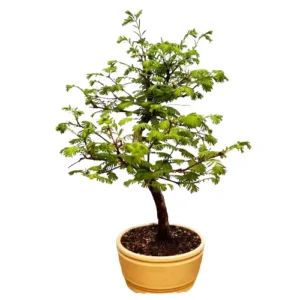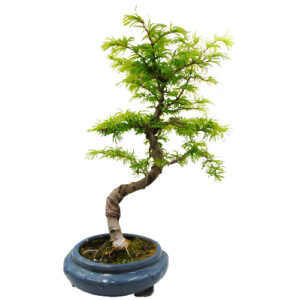Golden Larch Bonsai Tree (larix) is a deciduous conifer best kept outdoors. Golden Larch bonsai tree are quite low maintenance and famous for their gold autumn colour
Golden larch (larix)
Placement
The Golden larch bonsai tree is an extremely hardy species that can tolerate harsh conditions well and should be kept outdoors. Look for a spot that receives bright and full sun, it will not thrive indoors. Provide some shade on the hottest of summer days to protect against scorching the needles.
Action does not necessarily need to be taken during the winter and it can be kept outside all year round as these species can survive freezing temperatures down to -20 °C.
Watering
There is no definitive guide to watering and it should be conducted on an observational schedule, not a routine. This means that it is important to keep an eye on the moisture levels of the soil to avoid over and under watering, both which can lead to dropping leaves and/or root death. The amount of water a golden larch bonsai tree requires depends on pot size, climate, airflow, soil and tree type so it is best to use your eyes and fingers to assess whether the soil is damp, wet or dry. As a general guide, if the top inch or so has dried, it is ready to be watered. When you water, ensure an even coverage over the roots and soil, allowing water to flow out from the bottom of the pot to allow for a good soaking. Never let the soil dry out completely and never let your golden larch bonsai tree sit in water for long periods of time.
Fertilising
Pseudolarix amabilis
Using fertiliser on your golden larch bonsai tree will help encourage healthy growth and this should be done periodically from once a week to every two months and only during the growing season. You can start adding nutrients to your water from March until October and use weekly. If using solid fertilizer, use once every one to two months. With golden larch bonsai trees, less is more and we tend to advise using half the recommended dosage to see how your bonsai reacts first.
Larches do best with a high nitrogen feed in the early part of spring, just before the buds start growing. Once they have developed vigorously, you should change to a more balanced fertiliser to help it harden off for the winter.
Pruning and wiring
Pruning your bonsai is important not only to maintain or create an aesthetic style but to also ensure light and airflow can reach inner leaves and the Golden larch bonsai tree tolerates constant pruning very well. This is best done in in winter or early spring, before growing starts and undesirable buds should be removed before they open.
Training your bonsai using wiring is best done during the spring and autumn periods when the branches are visible and the buds are about to sprout. Larch branches are very pliable and can easily be shaped into desired styles. Do not worry if the wires bite slightly into the bark, the shallow marks will grow out within 1-2 years.
Repotting
Pseudolarix amabilis
Repotting your tree is an important way to provide a fresh and suitable soil mix and ensure appropriate root health. As a general rule, your larch will need to be re-potted every one to two years, and only in spring when the buds begin to extend, but you should check if it has become root-bound before you change pots. You can do this by lifting the tree gently out of the pot by the main trunk and examining the root system. You will know it is ready if you can see the roots are circling around each other and the pot. If, however they still appear contained in the soil, you should place it back and wait until the following spring to check again. Take care to minimise disturbance when repotting a larch as the roots are intolerant to a lot of pruning and do not like to be left bare.
Pseudolarix amabilis
Showing all 2 results


